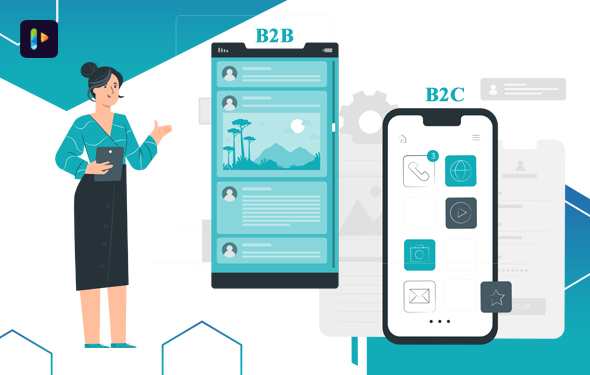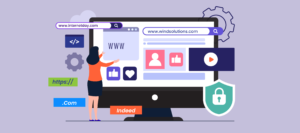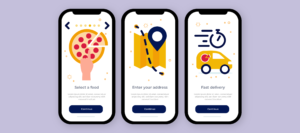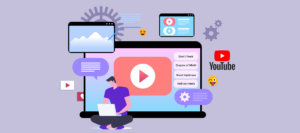Identifying the target audience is the most crucial step when planning any business or program. This is also true when you are planning mobile app development – you need to identify who the target users will be. You do not build an app just for fun, you must know who you are building the app for; this will determine everything that will go into the app, such as the UI/UX design, features, functions, terminologies, and name–everything must be designed or planned to suit the target users.
Latest Blog – Top Benefits of Incorporating Test Automation And DevOps
When targeting the users of your app, it is essential to classify or differentiate between B2B apps and B2C apps.
What Are B2C And B2B Apps?
Business to Consumer (B2C) apps account for more than 65 percent of all apps in the app stores. B2C apps are meant to be used by endpoint consumers or users. These apps deliver a wide range of functions for users, from entertainment to utility and lots more. Some examples of B2C apps include Uber, Airbnb, Bonobos, etc. There are more than 9 million apps on the apps store, allowing you to choose the apps that can serve the functions you desire.
Business to business (B2B) apps is targeted at other businesses. This means that you design and build apps that other businesses, companies, or staff will use to run the business, perform tasks, monitor inventory, or deliver services or functions that are the core of their business.
Point of sale apps, sales apps, enterprise apps, inventory management apps, and other classes of apps are in this category. Apps, such as Salesforce, Hootsuite, Asana, MailChimp, and a whole lot of others that you only hear about in the business environment fall in this category of B2B apps.
What Are The Differences Between B2B and B2C Apps?
When comparing B2B apps and B2C apps, they are different from each other in the terms of design, feature sets, execution, and lots more. The target consumer psychology of these apps is the primary determinant of their differences. Suffice to say that B2C apps offer different solutions, meeting different needs and expectations than B2B apps. However, it will help to examine their differences.
1. B2C Apps Have Simple Designs
B2C apps must have simple designs to enable even the simplest users to use the app without hassles. Using B2C apps should not require any special training or techniques. Everyone must be able to use it, irrespective of their educational background. The user interface must be simple and clear.
Any B2C app that appears complex and difficult to use usually gets abandoned by users because several other similar apps are simple and easy to use. On the contrary, B2B apps are targeted at specific groups of people working for a company, mainly professionals with years of experience with technical knowledge to use the app without hassles. B2B apps are designed to handle complex tasks.
2. B2B Apps Have Higher Marketing Cost Per Lead
How B2B and B2C apps get users are different from each other. B2C apps are usually available on the app sores and discovered easily in the stores or through online ads, recommendations from friends and family, other users, etc. Several other means are explored to give exposure to B2C apps, and the major goal of B2C marketing is to acquire a large number of users.
On the contrary, B2B apps use a more internalized means. They are usually disclosed or pushed to the Frontline through professional journals, trade shows, and networking. The reason for this method is that B2B apps are usually specialized apps designed for special functions. As a result, they need the approval of key decision-makers. This causes the marketing cost per lead of a B2B app to be higher than in B2C apps.
3. The Use of B2C Apps Can Be Emotion-driven
B2C apps are mostly downloaded for personal use, which may be driven by entertainment, wellness, communication, shopping, and lots more. How often these apps get used depends on the emotions of the users, such as mood, season, time, brand reputation, trends, and friends’ opinions. Besides, users’ decisions to download and install or uninstall the apps can be triggered by emotions, which cannot be controlled by app developers.
Meanwhile, B2B apps have the competition to beat and other factors to satisfy before being installed and used – the decision to download and uninstall is not emotion-driven. They are driven by their professionalism.
4. Differences in Design Concepts
The design of B2C apps is based on the understanding of the end consumers’ emotions. The UI designs result from extensive user research and psychological profiling to understand patterns, designs, and colors that can easily connect with users.
The design of B2C apps is usually driven by the need to create a sense of urgency and stir the user’s emotion, through layouts, colors, flashing buttons, and micro-animation to create a childlike delight. All these results from an attempt to take advantage of user emotions.
On the contrary, B2B apps are free from emotion but focus on the core functions that will be served and getting the job done most professionally. They must increase efficiency, save time, reduce cost, and increase productivity. However, that does not mean that B2B apps should be dull, unattractive, or have poor UX.
5. Different Monetization Approaches
B2C apps and B2B apps are monetized differently. B2C apps rely mainly on ad revenue, in-app purchases, and a percentage on download charges. B2C apps also earn through the subscription model but only a handful of the apps are successful like Spotify, Amazon Prime, and Netflix.
On the other hand, B2B apps do not bother with ad revenue or in-app purchases, they charge high prices upfront, which may be a one-time payment or yearly payment.
6. B2C Apps Require Regular Updates More Than B2B Apps
Both B2C apps and B2B apps require updates, but B2C apps need to be updated more frequently to remain relevant and modern and engage users than B2B apps. In view of this, developers regularly tweak designs, update colors, fix bugs, etc. to make B2C apps delightful to use for users. However, B2B apps are updated less frequently because businesses want to maintain a sense of permanency.
Takeaway
From the above, the differences between B2B apps and B2C apps are clear, from design to development, marketing approach, methodology, and monetization. As a result, if you are planning to build an app, you should ask your developer relevant questions before building an app to ensure that the goals are clear and the app will achieve the intended purposes.




